The Finest Engagement Ring Brands
Choosing an engagement ring is a significant milestone in one’s life journey, and finding the perfect brand can make this experience even more memorable. Some brands stand out among the…
Diamond Clarity – Basics
Diamonds in the top five categories all have identical clarity to the naked eye. The takeaway? This essential C presents an opportunity to stretch your budget. 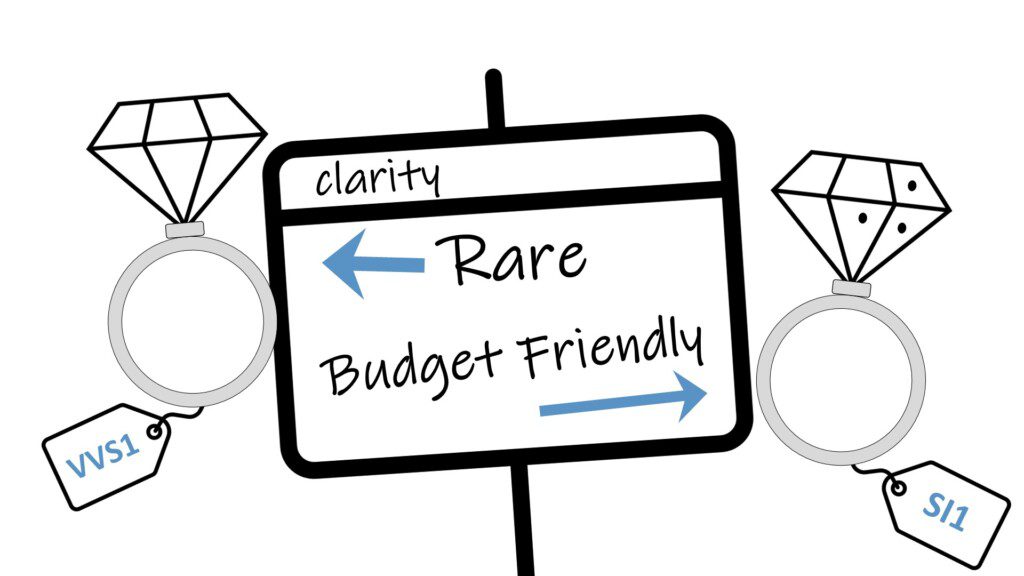
PriceScope Pointer: The most purchased clarity grades are VS1, VS2, and “eye clean” SI1. Learn how to define and find a diamond that’s eye-clean just below.
Before going on: Check out the PriceScope Diamond Buying Guide
These pages may reference products from companies that help to support PriceScope.
Intermediate Diamond Clarity
Advanced Diamond Clarity
The world’s natural diamonds formed between 1-3 billion years ago, 100 miles beneath the earth’s surface. As they grew, chemicals and elements present in the earth became trapped within their crystal lattices. Clarity evaluates a gemstone’s relative freedom from such internal characteristics, classified as inclusions, and from surface characteristics, classified as blemishes.
Stay Safe: Respected companies like JamesAllen.com, Blue Nile, Whiteflash, and our other fully vetted vendors only sell diamonds graded by Top Tier Laboratories.
Where To Buy Loose Diamonds? Our elite list of vetted vendors like Whiteflash and James Allen are experts at listening and helping you determine which combo of the 4Cs is perfect for you - and nicely in budget. Contact Us and get help today.
“Eye-Clean” Definition
Set aside the 10 clarity grades for a moment: Many people just want an “eye-clean” diamond, meaning one which has no inclusions invisible to the naked eye. There is no laboratory definition for this, but a PriceScope survey of gemologists resulted in this consensus:
Eye-Clean: No inclusions visible to the unaided eye when viewed from the face-up position in daylight equivalent or fluorescent lighting between 6-12 inches from the eye using 20/20 vision.*
*Ask your vendor for their specific definition.
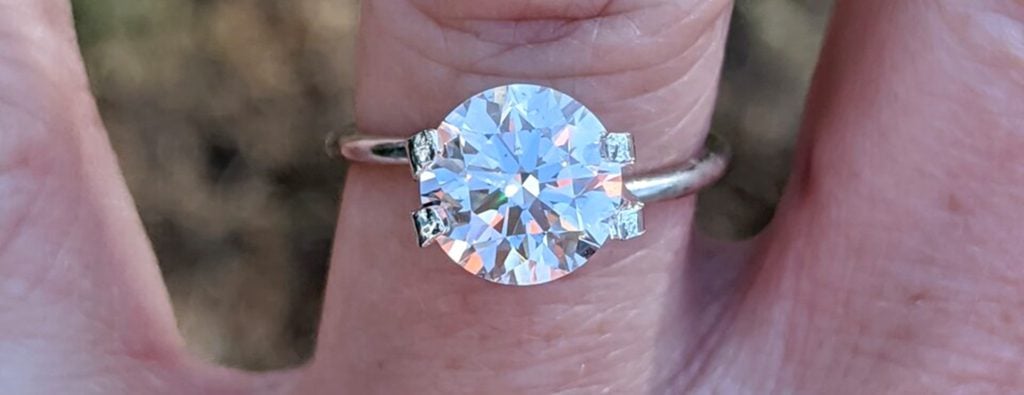
Great news! When graded by a top-tier laboratory, loose diamonds with VS2 clarity and higher are reliably eye-clean. Even better? You can frequently find diamonds with SI1 clarity which are eye-clean. It’s rare, but sometimes you might even find an SI2 diamond that meets the definition.
When graded according to strict, internationally accepted standards round brilliant diamonds with VS2 clarity and higher are reliably eye-clean. For shapes that show inclusions more easily (step cuts like emeralds and Asscher’s), VS2 clarity should be checked on a case-by-case basis.
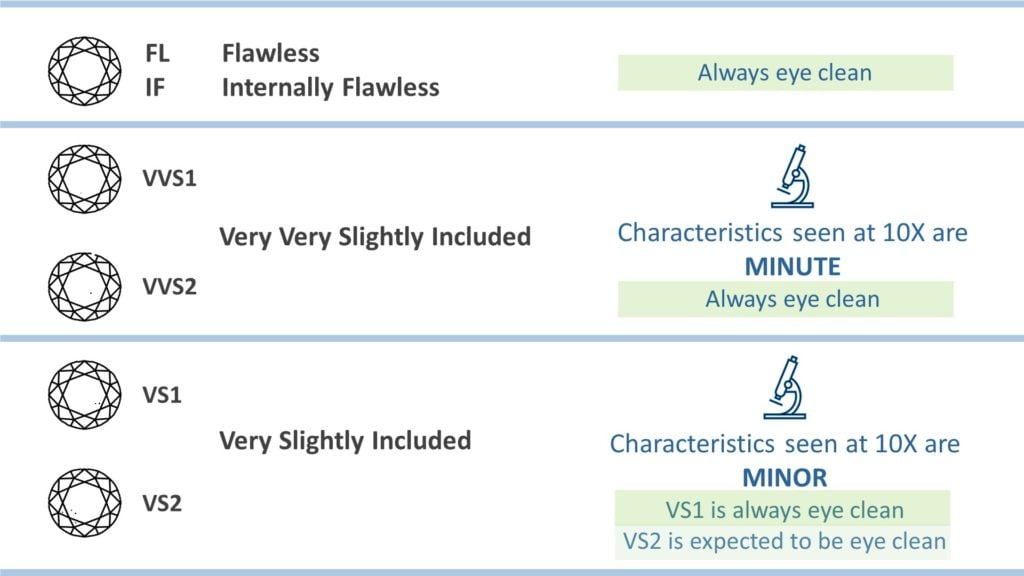
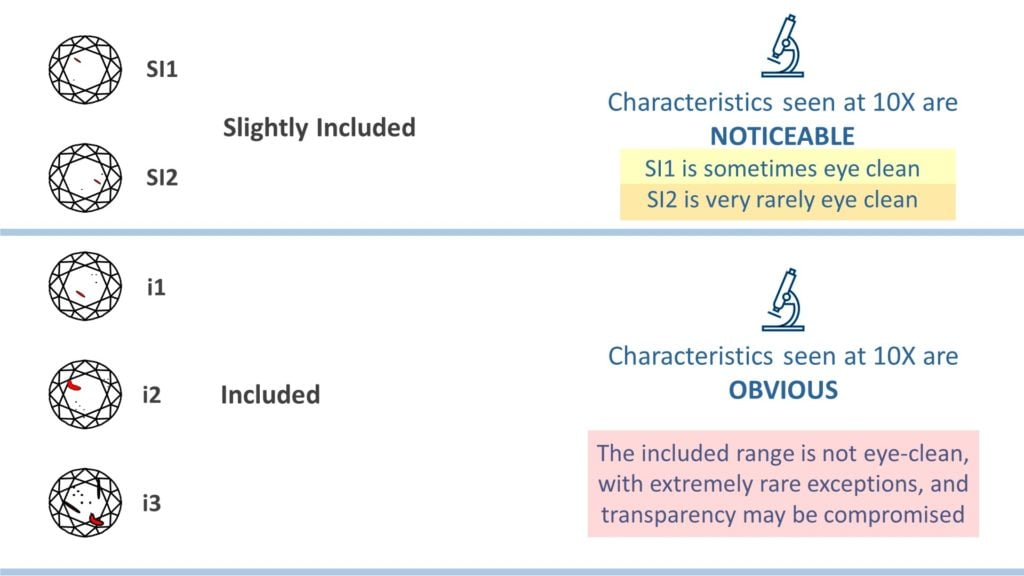
Find eye-clean diamonds with our vetted vendors right now: Whiteflash posts an eye-clean definition and inspects their in-house diamonds, and notes which are eye-clean on the diamond pages.
A clarity plot is a map. It’s created by the diamond grader to identify where observed characteristics are located. You can’t judge the severity or naked eye visibility of any characteristic based on the plot. The clarity grade is more meaningful than the list of inclusions: A feather plotted in a VS1 diamond should always be safe – with rare exceptions, such as a feather at the corner of a princess cut where pressure will be applied during setting. Alternately, a feather plotted in an I2 diamond is probably a durability risk.
The first characteristic listed may have been the “grade setting” inclusion or blemish, considered most significant by the grader. Here again, the clarity grade is most meaningful. A grade setting VS1 feather is always safe. A grade setting I2 feather is likely a durability risk. In the lower clarities, it’s also possible for several inclusions to qualify as grade setters.
Top-tier laboratories take a uniform approach to plotting. With that said, it’s not unusual for plots for one diamond to differ, laboratory to laboratory: In the VS2 example below the GIA grader considered only two crystals significant enough to plot and omitted the needle.
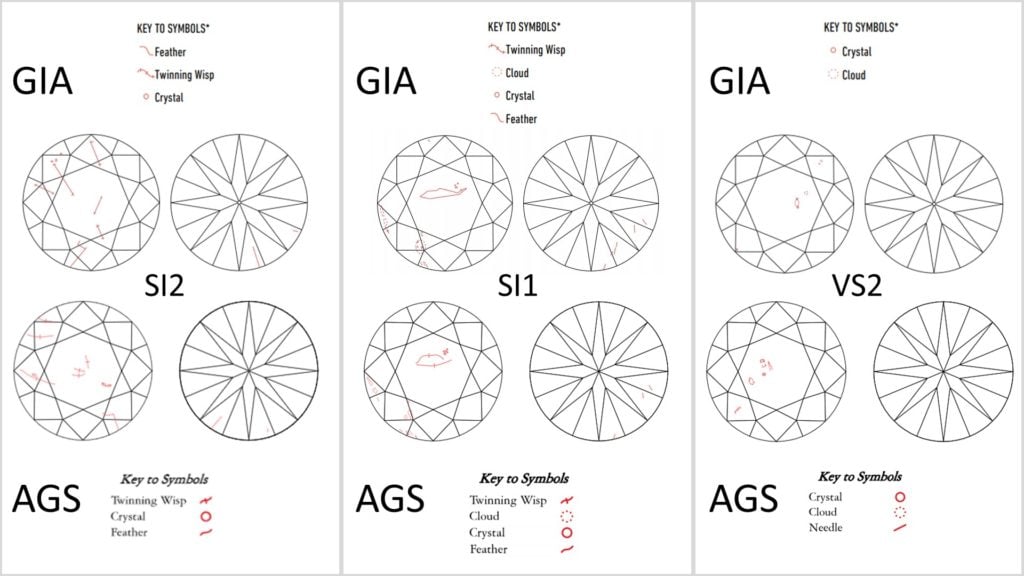
The number of inclusions listed on a report doesn’t correlate to whether a diamond is eye-clean. Here again, the clarity grade is most meaningful: Grades VS2 and above are typically eye-clean, with rare exceptions. In fact, VS2 diamonds (and many diamonds in the SI range) are often more likely to be eye-clean if several inclusions are listed, rather than a single inclusion that set the overall grade by itself. This is especially true for step-cuts like emeralds and Asscher’s, with long, flat facets which are more transparent and revealing.
Online grading reports can look scarier than the original report. A grading report is an expensive document, printed and laminated with subtlety and sophistication. When converted to digital form the subtleties can be lost, causing the PDF to look more “angry” than the printed report.
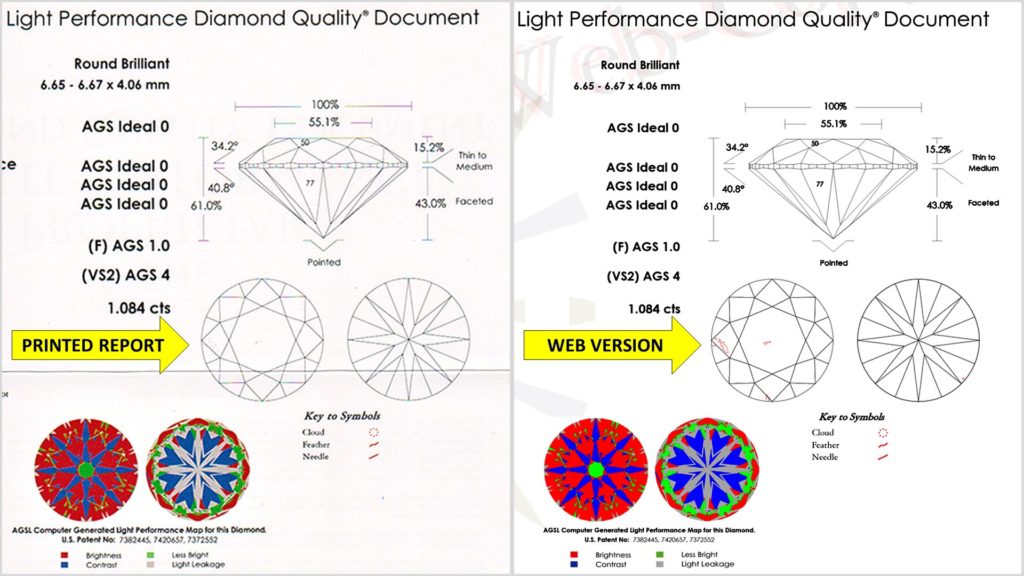
The photos and videos sellers post online for diamonds are heavily magnified. The average 1.00-carat diamond is only as wide as the eraser on the back of a small pencil. Keep that in mind when analyzing clarity in those images, along with the clarity plot on the grading report – which is only a map, not an indication of inclusion size.
Grading reports indicate where diamond clarity characteristics are, but give no scale. Sometimes an inclusion on a clarity plot can look big and scary, but that inclusion might be completely transparent and invisible. Online diamond videos and photos are great to have, but they can show diamonds at a huge scale, frequently at far higher magnifications than they were graded. This is like zooming into someone’s face on a 4K HD television. When you see someone’s cheek stretched across a 60-inch screen you can literally see every pore. But in real life, you’d never see a person like that.
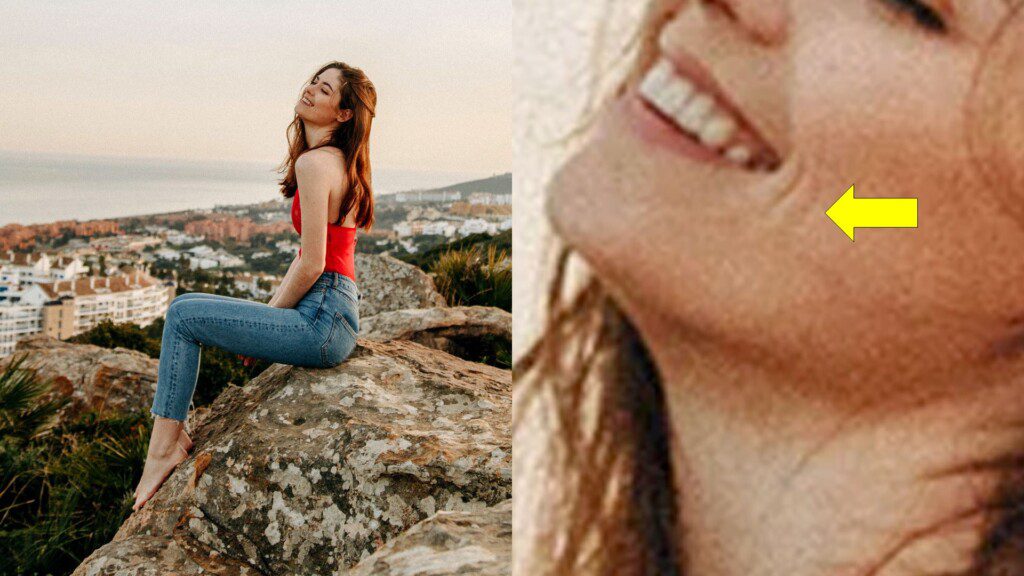
PriceScope’s 1-5 star ratings are categorical comparisons with the most thorough, consumer-focused online diamond and jewelry vendors, in categories, we believe reflect our experienced consumer community’s values. Check out PriceScope Jeweler Reviews.
Unlike carat weight, which is standardized, color and clarity grading are subjective human estimations. Moreover, some laboratories have softer standards than others: The diamonds seen in many chain stores, malls, and discount outlets have noticeable tint at higher grades, unlike diamonds sent to top-tier laboratories. This can give shoppers a false and negative first impression about warmer color.

PriceScope Pointer: Take a cut quality shortcut. See our Descriptive Proportions Chart to know whether a round diamond shows more brightness, more fire, or a balance of both. Our longstanding Member Recommended Proportions are listed there too.
Can I Choose Clarity Online With Confidence?
YES.
Successful online sellers like our recommended PriceScope vendors, have methods of reliably classifying and communicating diamond clarity, whether you’re examining it in-person or purchasing online. They also offer liberal inspection periods and free returns so you can make your purchase with complete confidence.
PriceScope Pointer: GIA, AGS, IGI, and GCAL all grade loose diamonds with strict, reliable standards. Read more about these laboratories on our diamond certification page.
A diamond’s clarity grade and appearance can be influenced by many factors, beginning with five gemological considerations considered by graders, as well as the diamond’s shape, carat weight, and – importantly – factors beyond 10x magnification that may go unreported.
In addition to visibility at 10 power magnification, gemologists also consider Location, Number, Color, Size, and the Nature of inclusions and blemishes when deciding the diamond clarity grade.
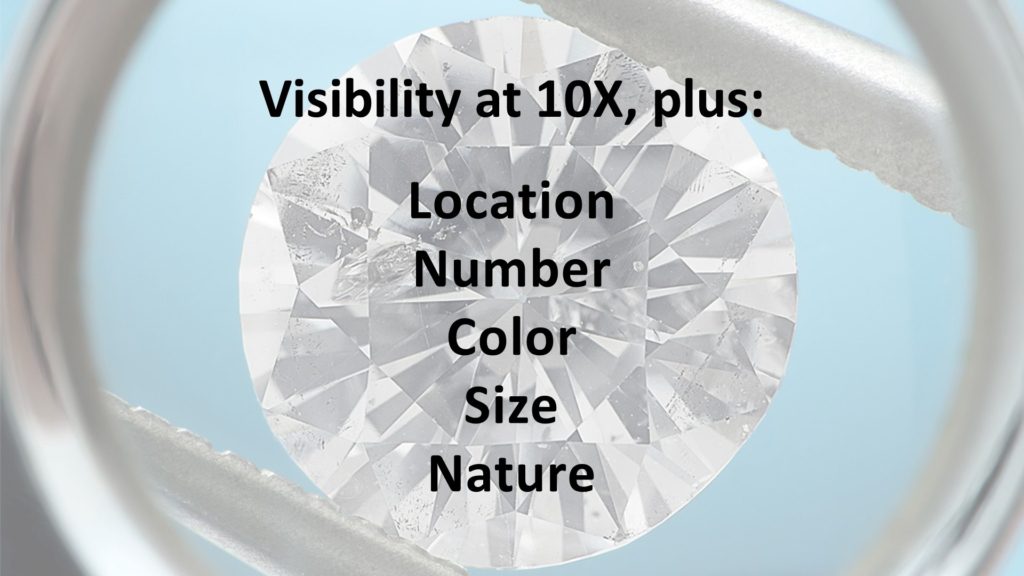
An inclusion’s location in the diamond can influence many things. Visually, an inclusion in the center of the diamond may be reflected by other facets, making it seem to appear in many places. Alternately, if the same inclusion is located near the girdle (edge) the clarity grade will be impacted less. Certain inclusions types that are completely benign when enclosed in the crystal may pose a threat to durability if they reach the surface. If there is any such threat the clarity grade will be lowered.
A diamond with a single iteration of an inclusion type is impacted less than a diamond with numerous iterations of that inclusion. Similarly, a diamond with a single inclusion type may be impacted less than a diamond with many inclusion types. When judging clarity this works hand in hand with the nature of the inclusions (described below).
When a grader analyzes clarity the inclusions can be transparent, white, black, or certain other colors. When a diamond’s inclusions are completely transparent the clarity grade will be impacted less than a diamond with opaque inclusions.
In grading clarity the size of inclusion matters, especially when considering its impact on the diamond as a whole. Logically, the larger an inclusion, the more influence it has on the clarity grade.
PriceScope Pointer: A diamond that has several tiny inclusions may be more desirable, in an eye-clean sense, than a diamond with a single large inclusion – which may be more visible.
In terms of clarity, the nature of an inclusion weighs how it may impact durability as well as visibility. A break within the stone may pose a durability risk, depending on its size and location, and the diamond’s clarity grade will be adjusted accordingly. Alternately the nature of a pinpoint is always perfectly benign.
If you’re looking to buy loose diamonds online, use our special tools to reveal the best cut quality diamonds! Start your diamond search and choose from over a million loose diamonds for sale. Use our filters to find either natural or lab diamonds, as well as fancy color diamonds.
The location, number, size, color, and nature of all internal and surface characteristics are considered together when establishing the final clarity grade.
PriceScope Pointer: Clarity characteristics that pose an obvious risk to durability should always be lowered to the I2 or I3 clarity grades. With that said, even the most flawless diamond can chip if struck the wrong way. For this reason, no different than your automobile, we recommend insuring your diamond jewelry.
In grades VS1 and below inclusions may be more visible in certain fancy shapes than they are in round brilliants. This is particularly true of emerald cuts and square-emerald cuts because their facets are longer, broader, and more transparent.
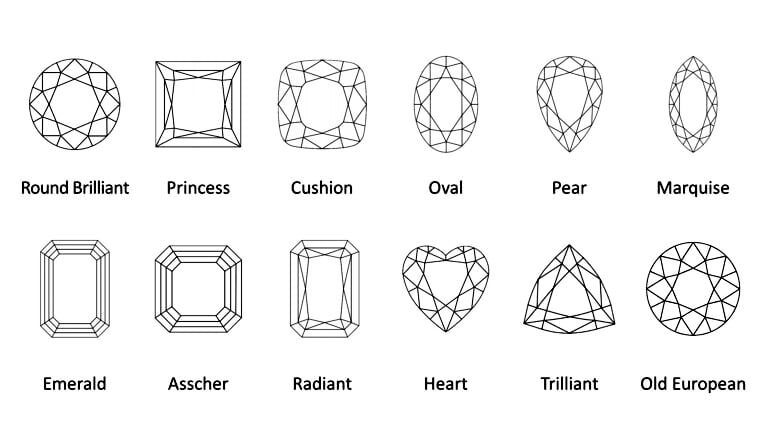
As diamonds increase in carat weight the inclusions present become more visible. Remember, the diamond’s clarity grade is based on how noticeable its clarity characteristics were when viewed at 10 power magnification, whether it weighs 0.25 carats or 2.50 carats.
Get Help On Clarity: Proven sellers like Blue Nile and JamesAllen.com specialize in listening and helping you determine which combo of the 4Cs is perfect for you – and nicely on budget. Call or chat now, and get help from one of our vetted vendors today.
Are you seeing diamonds that seem inexplicably low-priced? There are a few reasons this might be the case. One of them is a subtle or not-so-subtle brown, grey or green undertone having to do with its color appearance. Another may have to do with the undisclosed clarity issues described below. The endgame here is to always ask the seller why the diamond is discounted so much, but let’s arm you with some facts first.
A. “Clouds not shown” versus “Clarity grade based on clouds not shown.”
In clarity categories VS2, SI1, SI2, and below the comments “clouds not shown” or “additional clouds not shown” typically indicate the diamond grader considered them a non-issue. The comment is simply on the record for other gemologists who may examine the diamond later.
The comment “clarity grade based on clouds not shown” is a different matter. It indicates that the included pinpoints (clouds) were so widespread throughout the diamond that the grading category was determined by their presence, alone.
Since clarity grading is limited to 10X magnification characteristics beyond that scrutiny can go unreported. Haze is caused by large clouds of microscopic pinpoints when they become dense enough to interfere with light transmission and reduce transparency. Of course, clarity grading does not assess transparency. Occasionally a diamond with some level of haziness, caused by microscopic pinpoints, will pass through a grading laboratory with nothing disclosed on the report. This is because the pinpoints are not significant enough to merit attention when the diamond was analyzed at 10X magnification, but when taken collectively they still interfere with light transmission within the diamond. The resulting haziness can be very slight to severe.
Trade members refer to such hazy diamonds as being “sleepy,” a phenomenon that occurs on a sliding scale:
This is not typically an issue in diamonds of VS2 clarity and above, but when a VS diamond’s price seems “too good to be true” this could be the reason. In all cases, thorough vetting by an experienced professional will detect the issue.
These issues are disclosed among traders. Wholesale suppliers are being asked to declare a diamond has “No BGM” (brown/green/milky) in business-to-business comments, but those notes are not typically passed on from diamond sellers to consumers.
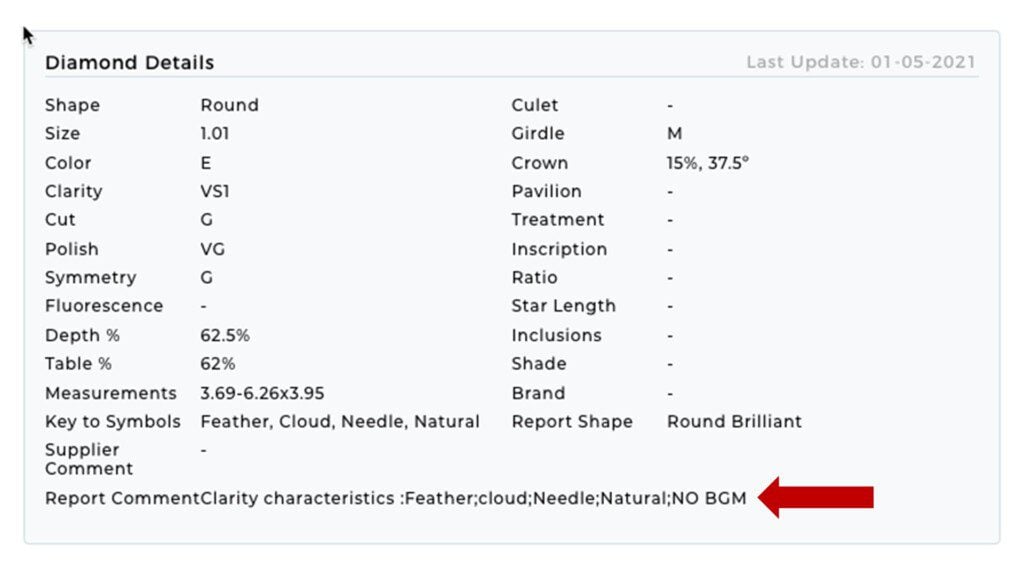
The world’s largest wholesale loose diamond trading platform has now added the ability to include or exclude “milky” diamonds (as a diamond clarity supplement) along with undertones of different shades, including brown, green, and grey (as a diamond color supplement).
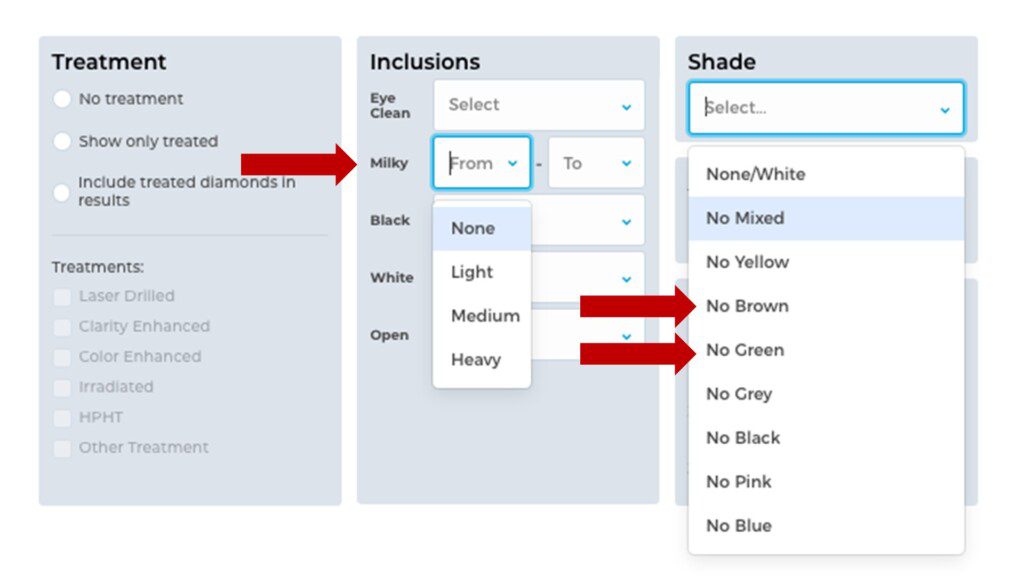
The situation is fluid, complicated by assessment thresholds and resistance to disclose, from miner to supplier to retailer to shopper. Much of the wild variability in diamond pricing is attributable to undisclosed elements such as these.
1. Revisit our advice above: Can I buy Diamond Clarity online with confidence?
2. Start with diamond grading reports, look for seller-provided photos and videos, look for standardized imaging and, most importantly, ask the seller directly: If you have questions beyond what a diamond grading report and supplemental videos and images can communicate, pick up the phone, chat or email and get in touch with the vendor. It’s in their best interest to communicate transparently with you. After all, they don’t want the expense of shipping a diamond, only to have it returned on their dime as well.
Anything in this section can be overruled by personal taste and preference. Many people just want eye-clean clarity, but some have strong feelings about high clarity and others go the opposite way, seeking low clarities on purpose.
There are no “wrong” beliefs when it comes to clarity, but when making your decisions it will be useful to know the information below.

There are a lot of preconceived notions about clarity. These may have to do with where someone grew up and what they learned about diamonds. Whatever the case, it’s a good idea to know how the wearer feels about diamond clarity and, in some cases, it may be enlightening to share this information with that person.
Many people are under the false impression that diamonds with higher clarity sparkle better. This is false. A diamond’s observable brightness, fire, sparkle, and contrast are all attributable to its cut-quality. Diamonds with identical cut geometry will sparkle identically at Flawless, VVS, VS, and clean SI clarities. A diamond’s optical properties are not influenced by inclusions and blemishes, except in the very lowest grading category Included: (I1-I2-I3): Those three grades are reserved specifically for diamonds with inclusions numerous or severe enough to impact light transmission and/or durability.
Collection quality diamonds are those with color and clarity combinations that trade for the highest values and continue to hold that value best over time. Combining D, E, or F color with Flawless, Internally-Flawless, VVS1 or VVS2 clarity gives a diamond collection quality status in the eyes of diamond professionals and enthusiasts. Some people choose those combinations for this reason.
Depending on culture and philosophy, diamonds may be seen as reflections of the relationships they symbolize. In such cases higher diamond clarity and color may be chosen, out of personal preference, to symbolize the perfection and purity of the union.
Depending on culture and philosophy, a diamond’s inclusions may be considered birthmarks created by mother nature (or the lab-grown process) which make them unique and special. When inclusions are easily viewed with a loupe or are eye-visible without magnification it also makes the diamond quickly identifiable.
A visible inclusion near the girdle (the edge of the diamond) may be what jewelers call “prongable” – meaning the inclusion can be covered with a prong when the diamond is set. This may be extremely positive for shoppers on a budget, as it can make a low-clarity diamond “eye-clean.” Just be sure the inclusion being pronged isn’t one that could be expanded or fractured as pressure is applied in the setting process.
GREAT NEWS for everyone 40-something and over. As humans age, we are all subject to the effects of presbyopia. What’s presbyopia? Farsightedness is caused by the loss of elasticity of the lens of the eye. While that means you won’t be able to read what’s written on a dime anymore it also means the small diamond inclusions you could barely spot in your 20s and 30s will now be invisible. Woo-hoo!

Get fast answers to any question: Ask our community of unbiased independent helpers.
People also ask
The best clarity depends on a number of factors which include the wearer’s preferences in terms of all the Cs, including carat weight, clarity and cut. To balance clarity against the other Cs, especially all-important cut quality, read the PriceScope Diamond Buying Guide.
Check out our Diamond Price Guide to see how different factors impact a 1 carat diamond’s price. We have also included a diamond price calculator for you to see today’s prices in real-time, based on more than 500,000 diamond listed in our search engine.
We always suggest prioritizing cut quality to maximize the diamond’s beautiful optical properties. Since the top six clarity grades are all the same to the naked eye you have a lot of room to choose. We encourage you to learn more about the more complex topic, Diamond Cut.
Get More Knowledge

Retail Diamond Prices Chart Updated Monthly.

Choosing an engagement ring is a significant milestone in one’s life journey, and finding the perfect brand can make this experience even more memorable. Some brands stand out among the…
Why should you get your Mom diamond jewelry for Mother’s Day? Diamonds are appreciated for their clarity and brilliance. In much the same way, great mothers offer their children clarity…
If you are looking to pop the question this spring, we have you covered for engagement ring shopping. We’ll add some proposal ideas too to inspire you when you take…

Want to stay updated on the most recent blogs, forum posts, and educational articles? Sign up for Bling News, PriceScope’s weekly newsletter.